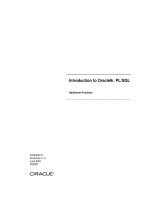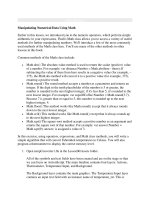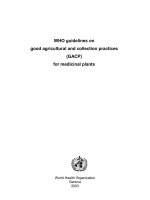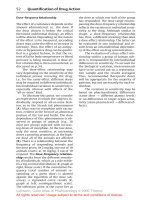math practices action ppt
Bạn đang xem bản rút gọn của tài liệu. Xem và tải ngay bản đầy đủ của tài liệu tại đây (3.09 MB, 59 trang )
Process
Standards for
Mathematics in
Action!
Building Background for
Educators
Project Information
This presentation hopes to answer two
questions for educators:
How do you integrate the Process Standards
for Mathematics into instruction of daily lessons
in conjunction with the content?
What does this integration look like for
teachers and for students?
Process Standards for Mathematics
1.
2.
3.
4.
5.
6.
7.
8.
Make sense of problems and persevere in solving them.
Reason abstractly and quantitatively.
Construct viable arguments and critique the reasoning of
others.
Model with mathematics.
Use appropriate tools strategically.
Attend to precision.
Look for and make use of structure.
Look for and express regularity in repeated reasoning.
Process Standard#1
Make sense of problems and persevere in solving them
What is a problem?
A problem
is defined as any task or activity for
which the students have no prescribed or
memorized rules or methods, nor is there a
perception by students that there is a specific
“correct” solution method.
Hiebert et al.,
1997
Make sense of problems and persevere in solving them
Students should be able to…
Explain
the meaning of a problem
Describe possible approaches to a solution
Consider similar problems to gain insights
Use concrete objects or illustrations to think
about and solve problems
Monitor and evaluate their progress and
change strategy if needed
Check their answers using a different method
Make sense of problems and persevere in solving them
Grade 5
There are 228 players in the softball league.
How many 12-member teams can be formed if
each player is placed on exactly one team?
Make sense of problems and persevere in solving them
Kindergarten
I have 5 things on my plate.
Some are peas. Some are carrots.
How many of each could I have?
How many peas? How many carrots?
Adapted
from Investigations in Number, Data, and Space
Make sense of problems and persevere in solving them
Teachers should…
Provide
Good Problems
To determine whether it’s a good problem, ask yourself:
1.Is the problem interesting to students?
2.Does the problem involve meaningful mathematics?
3.Does the problem provide an opportunity for students to
apply and extend mathematics they are learning or have
learned?
4.Is the problem challenging for students?
5.Does the problem support the use of multiple strategies?
6.Will students’ interactions with the problem reveal
information about students’ mathematics understanding?
Make sense of problems and persevere in solving them
Teachers should…
Facilitate
process
student engagement in the problem-solving
Provide
access to appropriate
tools/resources
Encourage discussion and questions
Support
students to
Make
sense of the problem
Make connections
Check reasonableness of solutions
Process Standard#6
Attend to precision.
Attend to Precision
Students should be able to…
Communicate
precisely to others
State meaning of symbols and definitions and
use them appropriately
Specify units of measure
Calculate accurately and efficiently
Attend to Precision
Grade 3
José ate ½ of a pizza.
Ella ate ½ of another pizza.
José said that he ate more pizza than Ella, but Ella said they both ate
the same amount. Who is right? Support your answer with words and
pictures.
Student A
Response
Student B
Response
Attend to Precision
Grade 6
.
How many toothpicks are
needed to make 4 hexagons?
5 hexagons? 10 hexagons? n
hexagons?
Student A
Response
I found a pattern of adding five
toothpicks for each hexagon. Since
21 toothpicks are in 4 hexagons, I
know that five more makes 26. I
could also multiply 5 by 6 and
subtract 4. Student B
Response
To find the number of
toothpicks in 5 hexagons, add
five to 21 (the number in 4
hexagons).
Attend to Precision
Teachers Should…
Model
appropriate use of mathematics vocabulary,
symbols, and explanations
Provide opportunities for students to share their thinking
Prepare students for further study
Process Standard#2
Reason Abstractly and Quantitatively.
Reason Abstractly and Quantitatively
Students should be able to…
Make
sense of quantities and their
relationships in problem situations
Contextualize and decontextualize
Create a coherent representation of the
problem at hand
Reason Abstractly and Quantitatively
Grade 1
Decontextualize:
Write a number sentence to
represent this story –
There are 12 girls and 13 boys in
Mrs. Johnson’s class? How many
students are in Mrs. Johnson’s
altogether?
Contextualize:
Write a story that could be
represented by the number
sentence 15 – 9 = ?
12 + 13 =☐
Liam had 15 pencils.
He gave 9 pencils to
his classmates. How
many pencils does
Liam have left?
Reason Abstractly and Quantitatively
Key Words are not the Keys to Mathematical
Reasoning
Reason Abstractly and Quantitatively
Key Words are not the Keys to Mathematical
Reasoning
Bernard had some coins. Samuel
gave him 6 more. Now Bernard
has 14 coins. How many coins did
Bernard have to begin with?
Reason Abstractly and Quantitatively
Grade 6
3 pineapples
1 serving = ½ pineapple
Given the information in the box above,
write a mathematics word problem for
which 3 ÷ ½ would be the method of
solution.
Reason Abstractly and Quantitatively
Teachers Should…
Provide
opportunities for students to
Express interpretations about number
Apply relationships between numbers
Recognize magnitude of numbers
Compute
Make decisions involving numbers
Solve problems
Reason Abstractly and Quantitatively
Teachers Should…
Draw
students’ attention to numbers and their
applications
Encourage discussion that promotes
reasoning
Process Standard #3
Construct viable arguments and critique the reasoning of others.









